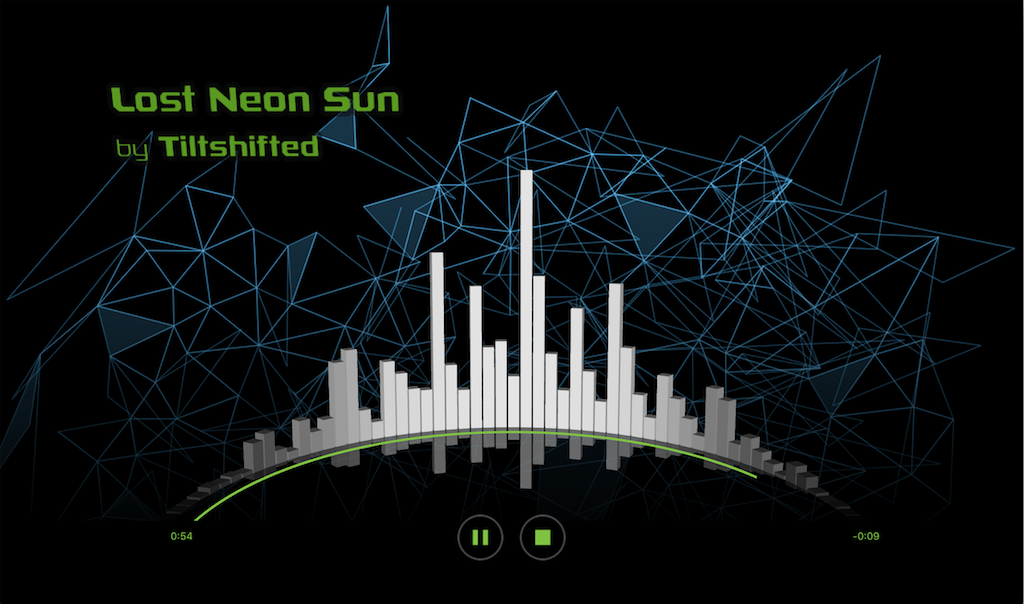演示组合 Qt 3D 渲染和 Qt Quick 2 元素。

音频 Visualizer demonstrates how to implement an application that combines the use of Qt 3D rendering with Qt Quick 2D elements. The example uses media player to play music and it visualizes the magnitude of the music as animated bars.
要运行范例从 Qt Creator ,打开 欢迎 模式,然后选择范例从 范例 。更多信息,拜访 构建和运行范例 .
Qt Quick 实现在
audio-visualizer-qml/main.qml
of the example uses
MediaPlayer
去播放音频内容。
MediaPlayer { id: mediaPlayer autoPlay: true volume: 0.5 source: "qrc:/music/tiltshifted_lost_neon_sun.mp3"
The player is controlled with the
playButton
and c{stopButton}. Based on the clicked buttons the
state
的
mainview
改变。
The 3D content is rendered using the
Scene3D
type. The state of the Audio Visualizer is maintained in the
mainview
. It's passed on to the
visualizer
as it's needed for the bar animations.
Scene3D { anchors.fill: parent Visualizer { id: visualizer animationState: mainview.state numberOfBars: 120 barRotationTimeMs: 8160 // 68 ms per bar } }
The 3D elements of the example are created in
audio-visualizer-qml/Visualizer.qml
. The camera is set to a fixed position to show the visualized bars from a correct angle.
Camera { id: camera projectionType: CameraLens.PerspectiveProjection fieldOfView: 45 aspectRatio: 1820 / 1080 nearPlane: 0.1 farPlane: 1000.0 position: Qt.vector3d(0.014, 0.956, 2.178) upVector: Qt.vector3d(0.0, 1.0, 0.0) viewCenter: Qt.vector3d(0.0, 0.7, 0.0) }
A
NodeInstantiator
is used to create the bars that visualize the magnitude of the music.
// Bars CuboidMesh { id: barMesh xExtent: 0.1 yExtent: 0.1 zExtent: 0.1 } NodeInstantiator { id: collection property int maxCount: parent.numberOfBars model: maxCount delegate: BarEntity { id: cubicEntity entityMesh: barMesh rotationTimeMs: sceneRoot.barRotationTimeMs entityIndex: index entityCount: sceneRoot.numberOfBars entityAnimationsState: animationState magnitude: 0 } }
visualizer
also contains an
Entity
to show the progress. This element has a curve shaped mesh and it's rotated on a level to show the progress based on the duration of the played track.
// Progress Mesh { id: progressMesh source: "qrc:/meshes/progressbar.obj" } Transform { id: progressTransform property real defaultStartAngle: -90 property real progressAngle: defaultStartAngle rotationY: progressAngle } Entity { property Material progressMaterial: PhongMaterial { ambient: "#80C342" diffuse: "black" } components: [progressMesh, progressMaterial, progressTransform] }
在
audio-visualizer-qml/BarEntity.qml
there are animations for rotating the bars and changing the bar color. The bars are rotated on a level following a ring form. At the same time the color of the bars is animated.
QQ2.NumberAnimation { id: angleAnimation target: angleTransform property: "barAngle" duration: rotationTimeMs loops: QQ2.Animation.Infinite running: true from: startAngle to: 360 + startAngle } QQ2.SequentialAnimation on barColor { id: barColorAnimations running: false QQ2.ColorAnimation { from: lowColor to: highColor duration: animationDuration } QQ2.PauseAnimation { duration: animationDuration } QQ2.ColorAnimation { from: highColor to: lowColor duration: animationDuration } }
The magnitude of each bar is read from a separate .raw file that is based on the track being played. As the bars rotate around the ring the height is scaled to highlight currently played position. After a full round of rotation, a new value is fetched for the bar.